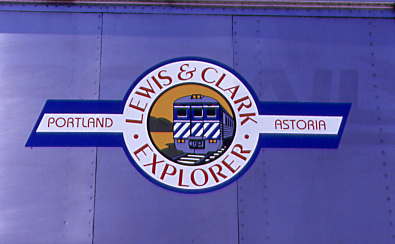
I started to hear rumors about Oregon running a special train from Portland to Astoria for the 200th anniversary of Lewis and Clark's trek to the Pacific Ocean. Jim Nowell sent me an e-mail advising me that it would be a go and Amtrak's new spring/summer timetable included a schedule for trains 998 and 999. It was planned to use former British Columbia Railway RDC's, until Amtrak had to back out of operating this special service as it was considered a "new service", and the company was allowed to start any new service until 2004.
The Portland and Western operates trains over this former Spokane, Portland & Seattle-built line, spun off by the Burlington Northern in July 1997. It was announced that they would operate the train, but from Linnton with a bus connection from Union Station. In my researching for this trip, I learned that Astoria now had a waterfront trolley and I talked to Steve Grande at Trainweb about a visit to Astoria and he agreed if the cost did not exceed $300. Amtrak wanted $268 for coach but I would be bussed from Eugene to Klamath Falls on the return, which I wanted to avoid. However, Shivam of Trainweb found a roundtrip on Alaska Airlines for $214 and I would also earn Alaska Airline miles. Karen, my friendly Amtrak agent at Solana Beach, made my Amtrak reservation. A call to the Mark Spencer Hotel in Portland resulted in a room for the two nights needed and I received my boarding pass on-line, earning a 1,000 Alaska Airline miles for doing it that way, so now I was all set.
Alaska Airlines 577 6/14/2003I was up early at 4:30 AM to prepare for my flight to Portland and after the usual domestic duties, my friend Bill Compton drove me to the airport where I breezed through security and waited for my flight. Boarding commenced at 6:15 AM and at 6:37 AM, we reversed from the gate and sat on the tarmac for fifteen minutes, first in line for takeoff with all the other departing planes behind us. At 7:00 AM, we took off, steeply climbing through the marine layer which had hidden the sun from Santa Ana for over a week and flew north, cruising at 39,000 feet. This flight was the first of four this summer that I had to take since time constraints barred me from riding the trains to my destination as I prefer to do. Mount Lassen and Mount Shasta were the two most beautiful mountains seen this morning and a lavatory visit enabled me to see Crater Lake. It was a quick and enjoyable flight and we landed on time.
Portland 6/14/2003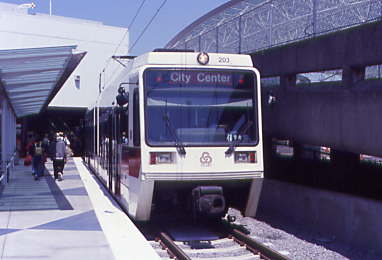
I had no problem finding the MAX light rail line at the airport which took me to Pioneer Square station in downtown in 35 minutes. Riding along the Union Pacific line reminded me of the good old days on Amtrak's Pioneer which used these tracks. Once there, I walked the three blocks to the Mark Spencer Hotel, the excellent establishment where I would be spending the next two nights, then walked to Union Station to learn where the bus for Linnton and my train departed from tomorrow morning. I then walked down Fifth Street and found a Carl's Junior for an early lunch before walking a block to a bus shelter to catch the 17 Bus over to 17th and Center across the Willamette River, and had no problem reaching my first destination of the day.
Brooklyn Roundhouse 6/14/2003This former Southern Pacific roundhouse was the second to occupy the site, the first one was built in 1912, had twelve stalls and was razed in 1959. In 1948, a four-stall "annex" was built which was home to Portland's steam engines since they were removed from Oaks Park for restoration many years ago.
About five minutes after debussing, Chris Fussell, owner of the Amtrak F40PH 231, arrived on his bicycle which he parked across the street at the Tri-Met offices and we walked over to the roundhouse.

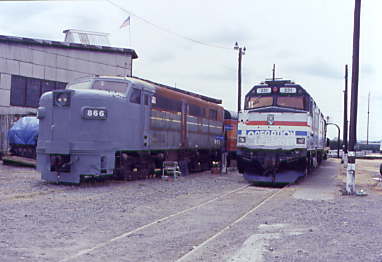
Amtrak F40PH 231 built by Electro-Motive Division in 1977. It worked for Amtrak from 1977 through 2001, pulling many trains across the midwest and western parts of the United States, with some trips to the eastern region as well as Canada. In October 2001, 231 operated its last revenue trip on a San Joaquin train into Oakland and was towed dead-in-train on the California Zephyr to Chicago, and then to Beech Grove, Indiana for disposition. Chris Fussell, a fan of the locomotive, then raised over $30,000 in ten days in fall of 2002 to purchase the locomotive for preservation. After it was transported from Indiana to the Brooklyn Roundhouse, 231 was donated to the Friends of SP 4449 Inc. a volunteer organization Chris volunteered at. It is owned by Dynamic Rail Preservation Incorporated.
On the left is Long Island Railroad power car 613, nee Spokane, Portland and Seattle FA-1 866 built by American Locomotive Company in 1950.
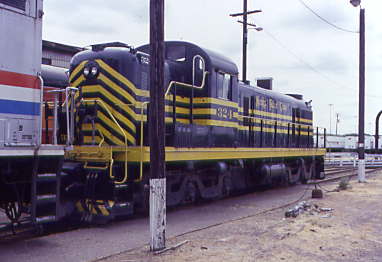
Nickel Plate Road RSD-5 324, nee Utah Railway 306, built by American Locomotive Company in 1955. It was sold to Industrial Salvage & Metals in Salt Lake City in 1983 and traded to the Promontory Chapter, NRHS, for scrap value in seven donated former Kennecott locomotives in January 1984. It was stored here until sold to Doyle McCormack in October 1993, painted as a fictitious Nickel Plate 324 by February 1994 and leased to Willamette & Pacific.

On one of the turntable leads, in perfect light, was Great Northern F7A 274, ex. Pete Replinger 274, exx. Seattle and North Coast 101, exxx. Burlington Northern 610, nee Great Northern 274B built by Electro-Motive Division in 1950.
Chris then took me inside the cab of 231, which brought back a flood of memories as I had ridden behind it many times. I also met Chris' mother, who was working at masking the cab to be repainted. Next we toured the roundhouse.
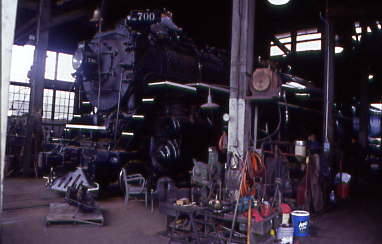
Spokane, Portland and Seattle 4-8-4 700 built by Baldwin in 1937. It ws one of three 4-8-4s purchased, mainly for passenger service. After showing it off to communities along the line, the SP&S quickly put them to work hauling passenger trains between Spokane and Vancouver, Washington. SP&S 700 and 702 would be used in overnight train service between the two cities. In 1947, the Great Northern streamlined its premiere train, the Empire Builder, and started using diesels for all its transcontinental passenger trains. The SP&S also purchased diesels, but they arrived after the streamlined cars so for a few months, SP&S 700 was used to pull the Portland section of the Empire Builder.
SP&S 700 was then used on secondary passenger service into the early 1950's before being displaced by diesels then went into freight service until 1955. In May 1956, the steam engine was spruced up for the "Farewell to Steam" run with 21 cars carrying 1,400 passengers on a Portland-to-Wishram round trip. After the trip, it was placed on the scrap line with other SP&S locomotives. Union Pacific had offered to donate a steam locomotive to the City of Portland for display in a park. Not to be outdone by its competitor, SP&S volunteered 700. The two locomotives were placed in the park in 1958, and were shortly followed by Southern Pacific 4449. They sat together for nearly two decades. In 1977, Chris McLarney started working on SP&S 700, cleaning and oiling various parts. He also started the Pacific Railroad Preservation Association provide support for the SP&S 700 restoration work. The restoration of SP&S 700 lasted until 1990 when it ran its first test runs. Since 1990, 700 has carried thousands of passengers to destinations all over the Pacific Northwest.
Chris also took me into its beautiful cab.
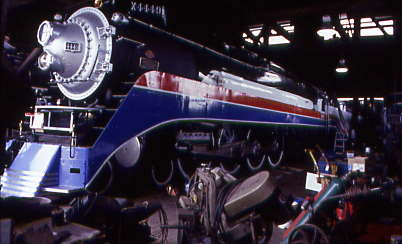
After that we went into my old dear friend, Southern Pacific 4-8-4 4449. It is the only surviving example of Southern Pacific's GS-4 class of steam locomotives. GS stands for "Golden State", a nickname for California (where the locomotive was operated in regular service), or "General Service." The locomotive was built by Lima Locomotive Works in May 1941; it received the red-and-orange "Daylight" paint scheme for the passenger trains of the same name which it hauled for most of its service career. Number 4449 was retired from revenue service in 1957 and put into storage. In 1958 it was donated, by the railroad, to the City of Portland who then put it on static display in Oaks Park, where it remained until 1974. It was restored to operation for use in the second American Freedom Train, which toured the 48 contiguous United States for the American Bicentennial celebrations. Since then, 4449 has been operated in excursion service throughout the continental United States.
4449 was the last engine manufactured in Southern Pacific's first order of GS-4 locomotives. 4449 was placed into service on May 30th, 1941, and spent its early career assigned to the Coast Daylight, SP's premier passenger train between San Francisco and Los Angeles, but it also pulled many other of the SP's named passenger trains. After the arrival of newer GS-4s and GS-5s, 4449 was assigned to Golden State Route and Sunset Route passenger trains. 4449 was re-assigned to the Coast Division in the early 1950s. One of 4449's career highlights happened on October 17, 1954, when 4449 and sister 4447 pulled a special 10-car train for the Railway and Locomotive Historical Society from Los Angeles to Owenyo, California, and return. In 1955, after being one of the last few Daylight steam engines in Daylight livery, 4449 was painted black and silver and its side skirting (a streamlining feature of the Daylight steam engines) was removed due to dieselization of the Coast Daylight in January of that year. 4449 was then assigned to Southern Pacific's San Joaquin Valley line, occasionally pulling passenger trains such as the San Joaquin Daylight between Oakland and Bakersfield as well as fast freight and helper service. 4449 was officially retired on October 2nd, 1957, and was placed in storage along with several other GS-class engines near Southern Pacific's Bakersfield roundhouse.
In 1958, when most of the GS class engines had already been scrapped, a then black-and-silver painted 4449 was removed from storage and donated to the city of Portland, Oregon, on April 24th, 1958, where it was placed on outdoor public display in Oaks Park. Since the equipment was considered obsolete, 4449 was not actively chosen for static display. It was picked simply because it was the first in the dead line and could be removed with the least number of switching moves. It was evaluated for restoration in 1974 after becoming a candidate to pull the American Freedom Train.
4449 was removed from display on December 14th, 1974 and restored at Burlington Northern's Hoyt Street roundhouse in Portland and returned to operation April 21st, 1975, wearing a special paint scheme of red, white and blue. As part of the American Freedom Train, the engine pulled a display train around the most of the United States. Afterwards, 4449 pulled an Amtrak special, the Amtrak Transcontinental Steam Excursion. After nearly two years on the road, 4449 was returned to storage in Portland, this time under protective cover and not exposed to the elements. In 1981, SP 4449 was returned to its original "Daylight" colours for the first Railfair at the California State Railroad Museum in Sacramento. In 1984, 4449 pulled an all Daylight-painted train from Portland to New Orleans, Louisiana and back, to publicize the World's Fair. The 7,477-mile round trip was the longest steam train excursion in American history. In 1986, 4449 went to Hollywood to appear in "Tough Guys" and pulled business trains for the Southern Pacific. No. 4449 had another famous moment in 1989 when 4449 and Union Pacific 4-8-4 844 made a side-by-side entrance into Los Angeles Union Passenger Terminal for the station's 50th anniversary celebrations. No. 4449 returned to Railfair in Sacramento in 1991 and again in 1999.
In 2000, 4449 was repainted black and silver for a Burlington Northern Santa Fe employee appreciation special, then was repainted into the American Freedom Train colours again in early 2002 after the events of the September 11th terrorist attacks.
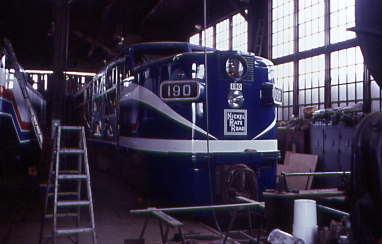
Nickel Plate Road PA1 190 built by American Locomtive Company in 1948. For Alco, the PA locomotive was their signature contribution to the booming streamliner passenger train equipment market following World War II. NKP 190 started life as Santa Fe 62L, one of twenty-eight such A-units ordered by the Atchison, Topeka & Santa Fe from Alco's Schenectady plant. After two decades in passenger service for the Santa Fe, the 62L and three sister units were put on the path to long-term preservation when the Santa Fe sold them to the Delaware & Hudson Railroad, where the PA 62L was given road number 18.
Also here was Oregon Railroad and Navigation 4-6-2 197 which later became Union Pacific 3207. Once I finished, I found Chris and thanked him for the wonderful experience before going back to the bus stop to begin another rail adventure.
Willamette Shore Trolley 6/14/2003The right-of-way of the WST dates back to the 1880's as a narrow-gauge steam railroad linking Portland to Oswego (as Lake Oswego was known back then) and south into the Willamette Valley. The Southern Pacific acquired the line and converted it to standard gauge. In 1914, the line was electrified and Red Electric Interurban service was born. One could board a Red Electric Car and ride to Portland, Beaverton, Hillsboro, Newberg, McMinnville and Corvallis. In 1921, the Elk Rock Tunnel was opened, replacing a wooden trestle that went around Elk Rock. Passenger service ended in 1929, but freight service continued until 1983.
In 1984, the Southern Pacific filed for abandoning the line from Lake Oswego to Portland. A Consortium of local governments and agencies acquired the line to preserve it for future transit use. In 1987, the Willamette Shore Trolley was born. The first car on the line was Blackpool Double-Decker 48, operated by the Oregon Electric Railway Historical Society. Later, a different entity operated other heritage trolleys on the line. The OERHS took over the service again in 1995 with the double-decker and later with a Portland Brill Master Unit streetcar.
The line was extended north to Riverplace at one point but was later cut back to Moody St to permit Portland Streetcar to enter the south waterfront district. The Double-Decker and the Master Unit were retired back to the Trolley Museum in Brooks due to the wear and tear of running the cars on the WST. The streetcar operated today is a modern-built Vintage Trolley. Vintage Trolley 514 was used on the Portland MAX line and Portland Streetcar as a tourist draw. The car is one of four cars built in 1991 for this service. Although popular with the tourists, the frequency of MAX and Portland Streetcar left little time slots for the VT cars to operate. St. Louis leases VT 511 and 512 for a new streetcar line and VT 513 and VT5 14 are now residents of the WST.
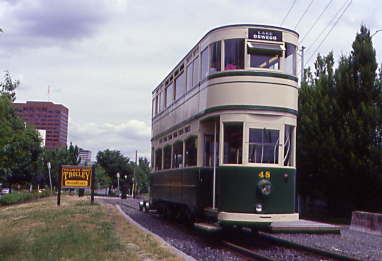
The bus took me across the Ross Island bridge and dropped me off at the first stop. I walked down the steep hill and found the tracks and off to the right was the Sheridan Street station, a flag stop. As soon as I arrived, here came Blackpool British double-decker 48 built by Blackpool Tramways in 1928. It is the only city in England that never stopped operating trams. This car is notable as it was the last tram to operate out of the Morton Depot in 1960. In 1962, the tram was shipped to the United States and trucked to their former museum at Glenwood.
I boarded and we climbed the short steep hill to the end of the line at River Place station and purchased a round trip ticket to Lake Oswego then rode in the front of the upper deck to not only enjoy the forward view, but to photograph the line as well. We left and returned to Sheridan Street station after we passed under the Marquam bridge. Minutes later, we crossed underneath the Ross Island bridge before travelling down the middle of Moody Street where we returned to a private right-of-way at Beaucroft Street. The trolley ran by River Forum where we started to have river views and passed between the condominiums before traversing a curved trestle. A wig-wag signal protected the entrance to Willamette Park with another wig-wag located at MP 771.10.
The trees covered the tracks, creating a tunnelling effect, which was really enjoyable, then we ducked under the Sellwood bridge and climbed up on a ledge on a grade of .84 percent thirty feet then up to forty feet above the Willamette River, passing the nice homes in Riverwood, where across the river was Powers Marine Park.

The trolley crossed a long curved trestle along the face of a rock cliff above the Willamette River.
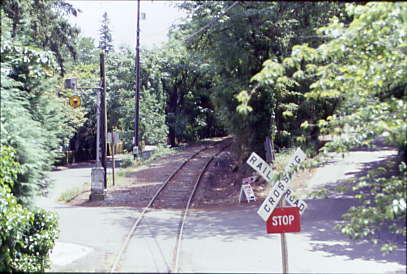
Passing the final wig-wag at a private driveway.
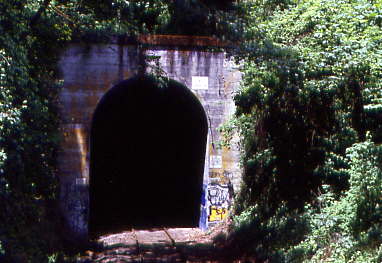
We plunged into the 22 foot high, 1,386 foot long curved Elk Rock Tunnel, passed a few more really nice homes before entering the town of Lake Oswego and went by the two-car car barn and arrived at the Lake Oswego platform.

I detrained, walked over to the depot building for some postcards and a view of Lake Oswego. On the return ride, we paused at the tunnel entrance for a history lesson. The line built in 1887 by the Portland and Willamette Valley Railway as a narrow gauge line and in 1892, the line was in full control of the Southern Pacific then converted to standard gauge. In 1895, the third rail was removed and it was sold to the Nevada-California-Oregon Railroad. In 1912, the line was electrified and "Red Electric" was in operation. Because of falling rock along Elk Rock cliff, it was decided a tunnel would be built and on December 5, 1921, electric train 301 was the first train through the new tunnel. The last electric operations occurred on October 5, 1929 but freight operation continued until 1984 when the line north of Wilsonia was abandoned.
The Oregon Electric Railway Society now operates the line on weekends. I had a relaxing ride back over the 6.67 mile route to Portland's River Place Station and I thanked the operator before walking up the hill and the five blocks to the Portland Streetcar, which I took back to the hotel. I went out to get a roast beef sandwich before returning to my room to rest.

That was until the hall became very noisy so I decided to visit the railroad section of Powell's Books before making a round trip on the Downtown Streetcar then returned to my room for the rest of the night.
Lewis and Clark Explorer 998 6/15/2003To commemorate the bicentennial of the Lewis and Clark Expedition, the Oregon Department of Transportation operated an excursion train along the south bank of the lower Columbia River from Linnton, near Portland, to Astoria, near the site of Fort Clatsop, where the Lewis and Clark Expedition wintered over in 1805-06.
Up early with anticipation of today's train ride and its accompanying new mileage, I prepared myself for the day and went downstairs for a continental breakfast. It was a beautiful clear morning as I walked down to Portland Union Station to wait for the shuttle bus to Linnton. All the passengers who did not drive out to the train were waiting in front until a single bus approached the MAX bus station across the street and the driver came over to get us.

The problem was that there were two busloads of people all trying to get on one and we filled it before a second bus arrived to take the overflow. Everyone was driven to Linnton and where I saw my old friends, former BC Rail RDCs 31, 11 and 10. I boarded the rear RDC, finding Aaron Hockley and Drew Mitchem, of Trainorders.com fame, who would be joining me and saved me a riverside seat.
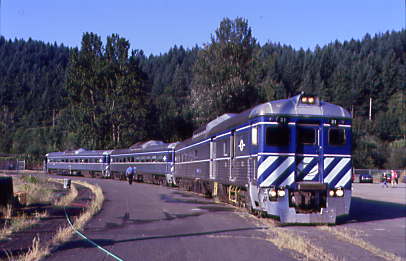
The Lewis and Clark Explorer trainset, led by Oregon Department of Transporation RDC-3 BC-31, ex. British Columbia Railway BC-31:2, ex. Amtrak 43, exx. Burlington Northern 2350, nee Great Northern 2350 built by Budd Company in 1956. The middle was Oregon Department of Transporttiaon RDC-1 BC-10, nee British Columbia Railway BC-10 built by Budd Company in 1955. The rear RDC was Oregon Department of Transporttion RDC-1 BC-11, nee British Columbia Railway BC-11 built by Budd Company in 1956.
Precisely at 8:00 AM, the train reversed out onto the mainline and past the stored passenger cars. Car attendants served everyone at their seat any food the passengers wished to purchase and a thirty-two page Lewis & Clark Explorer Train Journal was distributed. We ran along a branch of the Willamette River to our east where it empties into the Columbia River near Scappoose. US Highway 30 would follow our route to Astoria and we paralleled it at times then passed through United Junction where the line to Hillsboro splits off from our line to Astoria.
Our route took us through the communities of Burlington and Holbrook, Dave Mountain was to our west and a fresh water lake to our east. We next passed Rocky Point Marina before we curved around Prince William Bend then continued through Scappoose, which is a Multnomah Indian word for 'gravelly plain'. We passed through Warren and McNulty before proceeding through St. Helens, whose train station still stands, although it is used for another purpose nowadays then ran through Columbia City, where the Columbia River came into view, before reaching Waterview on the railroad which had a large lumber mill. We travelled along a section of natural forest, probably what Lewis and Clark went through on their journey back in 1805 and 1806.

Deer Island before we reached the Columbia River shore again at Goble then passed the Trojan Nuclear Power Plant, which was decommissioned in 1990 after twenty years of providing electrical power to a part of the Pacific Northwest.
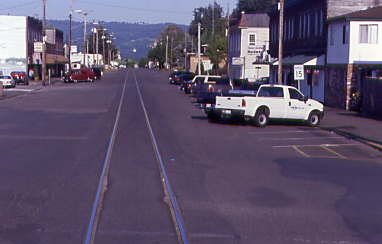
We slowly made our way down the street in Rainier then passed under the Rainier-Longview bridge and there were islands in the Columbia River; we passed Lord and Walker Islands. The jointed rail made for the familiar 'clickety-clack' sounds, after which the line grew really scenic as we ran on a ledge beneath a cliff and through a few rock cuts right along the river.
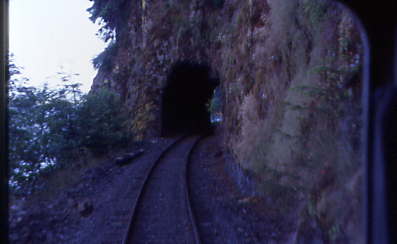
We plunged into the 184 foot long rock cut tunnel at MP 54.6 and after another mile of running right along the cliffs of the Columbia River, the valley opened and our speed increased as farms became more prevalent on the wide flood plain. We made our way to Mayger before passing Grime Island out in the river.
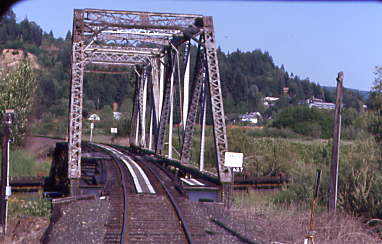
Further on, we ran through Clatskanie before reaching the drawbridge over the Clatskanie River MP 62.7. I enjoyed a cinnamon roll and while walking through the train, it was nice to see the BC Rail signs on the bathroom doors. We continued west, passing Marshland on our way to Westport then at Wauna, we ran by the large Georgia Pacific plant, which is the westernmost shipper on the railroad. Off in the Columbia River were Puget and Tenasillahe Island before we continued to Clifton then rounded Aldridge Point. The floodplain opened up again before Brownsmead and we reached the drawbridge at Blind Slough at MP 84.8.
At a grade crossing in Knappa was an operating wig-wag signal then we returned to the sloughs with the Lewis and Clark National Wildlife Refuge on Horseshoe, Marsh and Karlson Islands. The train ran through Svenson with its large houseboat population then beneath Fern Hill prior to running along Cathlamet Bay before reaching the John Day draw bridge at MP 94.8, where a section crew was waiting for us so they could return to work.

The Columbia River was becoming wider as we neared its mouth with the Pacific Ocean.
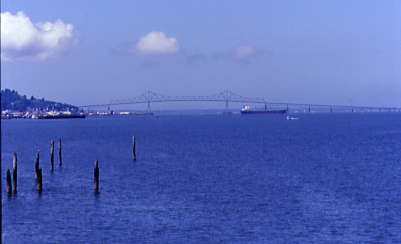
The Lewis and Clark Explorer proceeded to Tongue Point and after rounding it, Astoria and the four-mile-long Astoria-Megler bridge, which carries Highway 101, came into view.

We passed the Astoria Waterfront on our way to our final stop at the boarded-up former Spokane Portland & Seattle station.
Astoria 6/15/2003This was not my first visit to the Clatsop County seat as I first passed through here in our family camper in 1973.
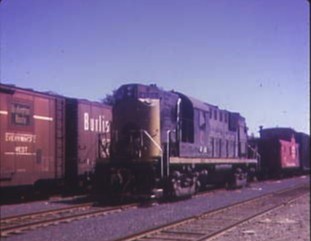
Burlington Northern RS-11 4186, nee Northern Pacific 906 built by American Locomotive Company in 1958.
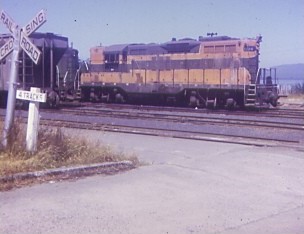
Burlington Northern GP9 1784, nee Great Northern 711 built by Electro-Motive Division in 1956.
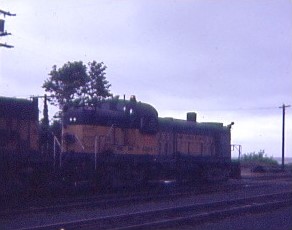
The following year, I photographed Burlington Northern RS-3 4064, nee Spokane Portland & Seattle 80 built by American Locomotive Company in 1953.
After pictures of the Lewis and Clark Explorer in front of the depot, we went in search of lunch, selecting the Silver Salmon Restaurant, who also caters the dinner service on the journey back to Portland. Aaron and I had the London Broil and Drew had the fish and chips with all meals excellent. We walked down to the waterfront for our next rail adventure.
Astoria Riverfront Trolley 6/15/2003The Riverfront Trolley is a three-mile heritage streetcar line that operates on former freight railroad tracks along or near the south bank of the Columbia River, with no overhead line. The service began operating in 1999 and the line's operation is seasonal, normally during spring break and from May through September. Volunteers from the non-profit Astoria Riverfront Trolley Association (ARTA) operate the service and maintain the streetcar and tracks, but the city of Astoria has provided some funds for certain purchases, including a new carbarn in 2001 and a contribution to the cost of purchasing the streetcar.
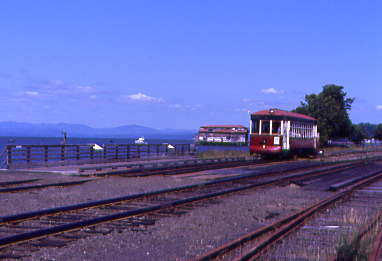
The three of us boarded Astoria Waterfront Trolley streetcar 300, ex. Witte Museum 300 (San Antonio) 1994-1999, exx. San Antonio Museum Association 300 1933-1994, exxx. San Antonio Public Service 300 1917-1933, nee San Antonio Traction 300, built by American Car Company in 1913.
This group of cars was numbered 300 to 313 and had composite car bodies constructed from both wood and steel. In 1917 the San Antonio Traction Company became part of The San Antonio Public Service Company. Streetcar service in San Antonio officially ended April 29, 1933, though some cars remained in service occasionally through the July 4th weekend. This was due to the slow delivery of new buses and a higher than expected rate of breakdowns of buses. Car 300 was presented to the Witte Museum on Sunday, April 29, 1933, with great fanfare and was run onto the museum grounds under its own power and parked. Witte Museum is the precursor, and an important part now, of the San Antonio Museum Association.
Old 300 was left outside, with little maintenance, until 1948. It then received housing and a superficial restoration, including filling rotted areas with plaster. Traction motors, air compressor and resistors were loaned out to another operation during World War II and never returned. In 1968, after the San Antonio World's Fair, a Transportation Museum was developed at the downtown fairground. Car 300 was again placed on outdoor, unsheltered display until 1980, by which time it had a rather terminal case of rot. The initial 1980-81 restoration ultimately required the use of car body 311, which had been scrapped in 1933. It had been placed under a metal shed and served as a woman's residence until 1978, when she entered a rest home and Mrs. Rhoda Billings donated her home for this restoration.
300's interior fittings and brass window sashes were used in this restoration. Broad-gauge New Orleans trucks and traction motors were acquired in Shreveport and standard gauged. The original four-foot gauge trucks are held by San Antonio Car Company to place under another San Antonio car to be restored. For about five years, Old 300 ran on the Willamette Shore Trolley line from Portland to Lake Oswego. Then for the next five years the trolley went to Gales Creek, where another restoration was begun and Old 300 ran at the Glenwood Trolley Park. The Glenwood Trolley Park was shutting down operations when the City of Astoria was made aware of the availability of Old 300.
Old 300 was leased from San Antonio for five years at $1 per year and brought to the MERTS facility in December 1998 for restoration. A makeshift shed behind City Lumber, East of the Barbey Center, was her home/maintenance shed until the completion of the current Trolley Barn in 2002.
Our RideWe rode out to the west end, first passing the car barn, followed by a stop at the Red Lion Inn and the West End Mooring Basin for pleasure and sport fishing boats. We continued past the rubble-strewn dock of the old Union Fisherman's Cooperative Packing Company, went behind Suomi Hall and the old Finnish Meat Market, now the home of the Astoria Street Opry Company then ducked underneath the 4.21 mile long Astoria-Megler bridge opened in 1966 as the longest continuous truss span bridge in the world, which was featured in the 1986 film "Short Circuit". Under the bridge is Maritime Memorial Park, dedicated to people who lost their lives in either the Columbia River or the Pacific Ocean.
Next we went by the site of the original Elmore Cannery, which later belonged to Bumble Bee Seafood and was closed in 1980. The Astoria Warehouse was the site of the American Can Company which supplied all the cans for Bumble Bee. There a large object in the river which was the cannery boiler, all that remains of the White Star Cannery, which burned down fifty years ago. The Columbia House was passed next and was Astoria's first condominium, built out over the water. The red brick building on the right was the Astoria Wharf and Warehouse and was nicknamed the "Bonded House" but was never used by US Customs.
The next point of interest was the Kinney Cannery building, built in 1876 and was placed on the National Register of Historical Places in 1989. The Kinney Box Factory, built in 1908, is now an office building with a bakery and shops. At Sixth Street, there was a viewing platform and dock from which locals fish. The 1906 building was the Elmore Dock and now hoses Bornstein's Seafood. That brought the trolley to the foot of Ninth Street, where the 1945 Sebastian- Stewart Fish Company building is now Astoria Holding Company, which operates a sardine plant. Up on 12th Street, the Astoria Sunday Market was in high swing. All downtown and the views on the hill can be seen for the duration of the trolley's route.
14th Street was the site of the George Hume Cannery and another riverfront park, where part of the film "Free Willy" was filmed. We ran along the water to the Columbia River Maritime Museum and the 17th Street dock, home to two Coast Guard cutters, "Alert" and "Steadfast", as well as the retired lightship "Columbia". We then passed the Spokane, Portland and Seattle station built in 1924 and the Lewis and Clark Explorer laying over for the afternoon. Up on the top of the hill is the Astoria Column, built in 1926 to commemorate the westward sweep and discovery. Ralph Budd, the President of the Great Northern, and the Astor family financially supported the Astoria Column. Visitors can climb the 164 steps to the top of the column and have a spectacular 360-degree view.
Back down to the rails, we travelled by the mill pond, all that is left of the Astoria Plywood Mill. Further on at 36th Street, over against the hill, is Astor School used in the film "Kindergarten Cop" and the Goonies House used in the film "The Goonies". Other films made here include "Benji, The Hunted", "Come See the Paradise" and "Teenage Mutant Ninja Turtles". We continued east to the East Side Mooring Basin, the end of the run, where the passengers flipped their seats and the operator and narrator switch ends before returning west. We rode to where we had first boarded and detrolleyed after a very fun and educational experience and walked over to the Maritime Museum so I could get some more postcards.
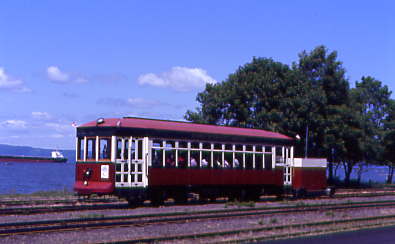
We walked east to the mill pond to photograph the trolley prior to going back to an ice cream shop where I enjoyed my first root beer float ice cream cone.
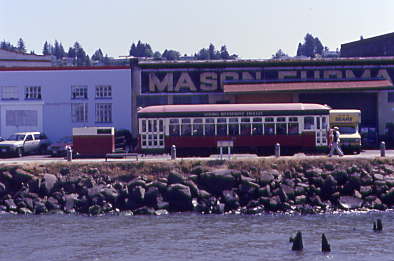
The Riverrront Trolley passing the RDC's as passengers were returning to board for the trip back to Linnton.
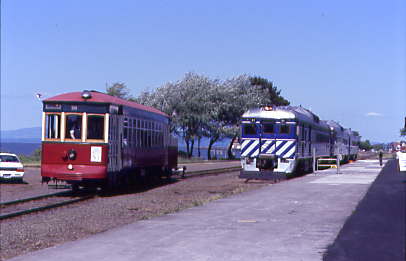
Riverfront Trolley 300 passing the RDCs.
Lewis and Clark Explorer 999 6/15/2003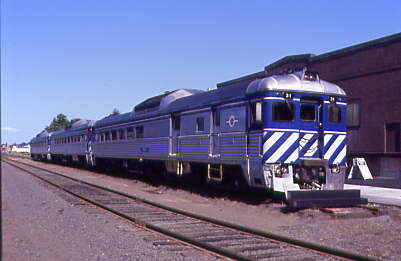
We departed on time and Aaron joined me at my seat, which allowed us to get to know each other better. We both enjoyed a hot dog for dinner, with the only minor drawback of the entire trip being a minor air conditioner problem. We knew we had a real problem when the crew brought out the manual. Sometimes the manual can be a useful tool, but this time, just opening the lead RDC's doors was enough to cool off the car.
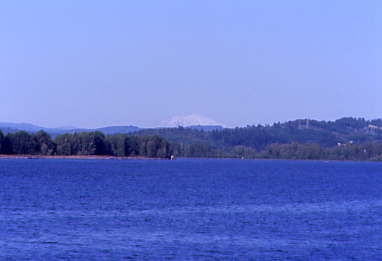
Mount St. Helens came into view, as did Mount Hood later.

It had been a great day of train riding with Aaron and Drew, but all good things have to come to an end and we arrived back at Linnton thirty minutes early. The shuttle buses were waiting and after one last picture of the Lewis and Clark Explorer, I boarded the bus and the nice driver dropped me off at 11th Street, which made my walk to the hotel a mere five blocks from my hotel. I called home to my mother before retiring for the night.
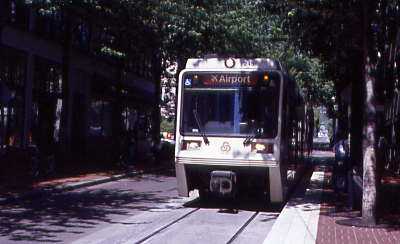
6/16/2003 Sleeping in late and following a continental breakfast, I prepared myself for the day then watched TVLand until I checked out then walked the three blocks to the MAX Light Rail stop and waited for a Red Line trolley to the airport, where I obtained my boarding pass from an Alaska Airlines machine using only my mileage plan number and earning another 1,000 points in the process. As I went through security, the extra set of car keys, which I keep in my wallet to avoid lockouts, set off the detector and I was taken over to a secondary security area where I was wanded but was able to keep my shoes on. I went to the Stump Town Bar and Grill for some buffalo chicken Wings for lunch and ollowed that with a cookie dough and chips ice cream cone as I enjoyed the views before going to Gate C-11.
Alaska Airlines 348 6/16/2003The flight was delayed from 2:30 PM to 2:50 PM flight and would stop in Oakland on its way to Orange County. I took my window seat on the 737-400 at 2:36 PM and we left fourteen minutes later.
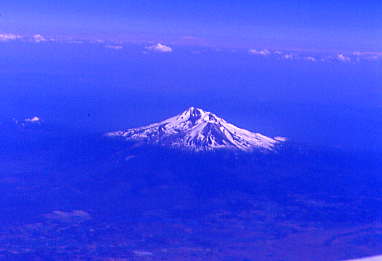
Mount Shasta and the view upon Pinole and the Carquinez Straits as we started our descent. We arrived at the gate in Oakland at 4:25 PM, the plane was cleaned and we departed half an hour later then flew out over San Francisco Airport, over the Pacific Ocean before banking south and flying down the California Coast. Arrival at the gate in Orange County occured at 6:15 PM, where I was picked up by my mother and we went to dinner at Coco's before going home, ending a unique trip to Portland and my ride on the Lewis and Clark Explorer.
| RETURN TO THE MAIN PAGE |